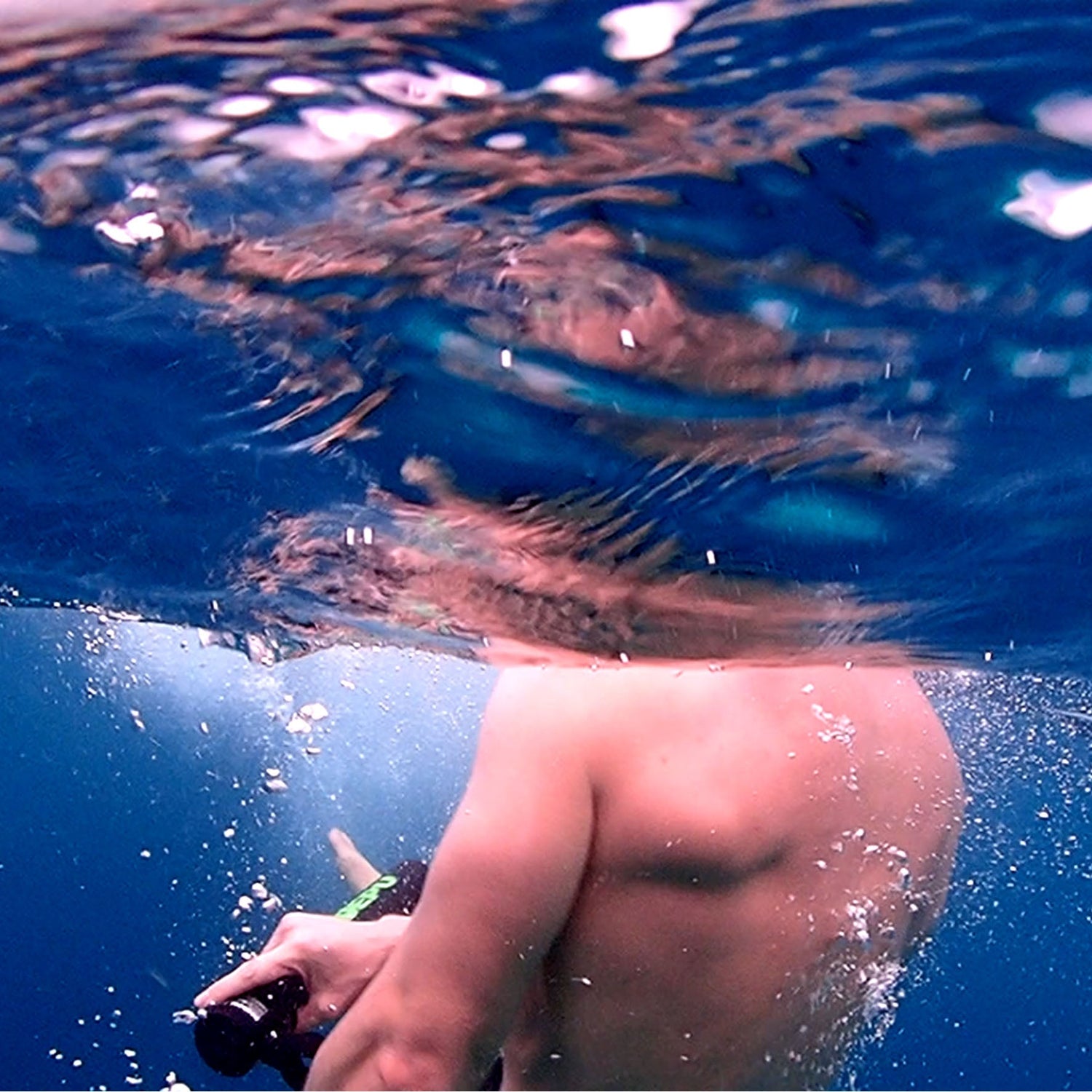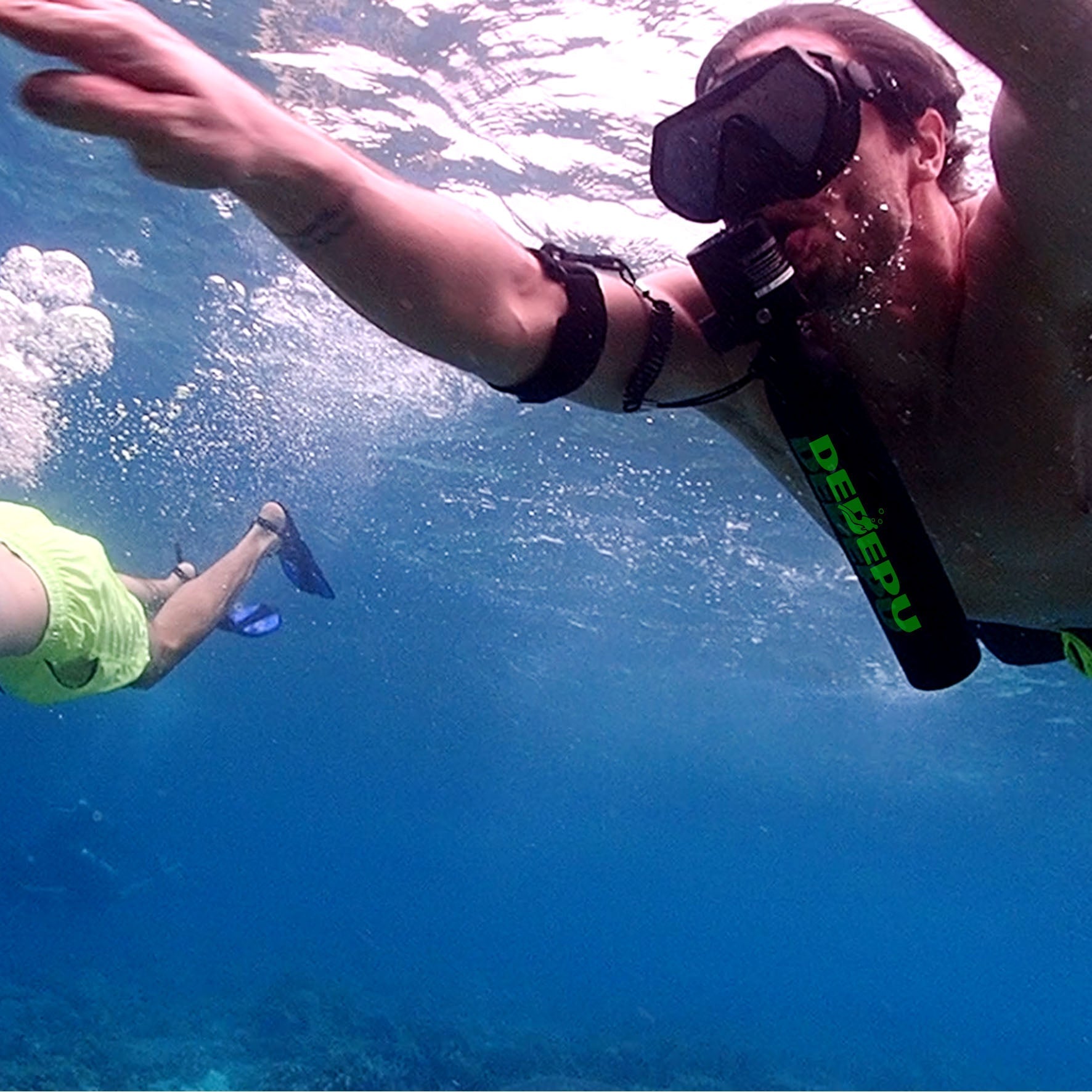These compact tanks, holding 2-3 cubic feet of air, are often used for 15-20 minute dives at shallow depths. Key safety checks include inspecting the pressure gauge (max 3000 PSI) and ensuring the valve seals properly. A 2022 study found that 85% of mini tank incidents were due to improper maintenance. To stay safe, always test the tank before use, avoid exceeding depth limits (recommended max 30 feet), and store it in a dry place. With the right care, mini tanks can be a reliable tool for casual underwater exploration.
What Is a Mini Scuba Tank?
A mini scuba tank is a compact, portable air supply designed for short underwater excursions. Unlike traditional scuba tanks (which hold 80-100 cubic feet of air), mini tanks are much smaller, typically storing 1.5-3 cubic feet—enough for 10-20 minutes at shallow depths (under 20 feet). These tanks weigh 3-8 lbs, making them easy to carry for snorkelers, freedivers, or emergency backup use.
Most mini tanks operate at 3000-3500 PSI, with aluminum or steel construction for durability. Their compact size means they have 50-70% less air capacity than full-sized tanks, so they’re not meant for deep or long dives. However, they’re popular for quick underwater photography, pool training, or as a safety reserve when snorkeling.
Air Capacity & Usage
A 3-cubic-foot tank at 3000 PSI provides roughly 15 minutes of air for a relaxed diver at 10 feet.
Breathing rate affects duration: An active diver (consuming 1.5 cubic feet per minute) will drain a mini tank 2-3x faster than a calm diver (using 0.5-0.7 cubic feet per minute).
Pressure & Safety Limits
Most mini tanks have a burst pressure rating of 5000+ PSI, meaning they can safely handle 2x their working pressure without risk.
Always check the pressure gauge before use—if it reads below 500 PSI, refill or avoid diving.
Regulator & Valve System
Mini tanks use a standard CGA-540 valve, compatible with most scuba regulators.
A poorly maintained valve can leak 5-10% of air per hour, reducing usable dive time.
Material & Lifespan
Aluminum tanks (lighter, 5-7 lbs) last 10-15 years with proper care.
Steel tanks (heavier, 7-10 lbs) have a 15-20 year lifespan but resist corrosion better.
Refill Costs & Frequency
A full refill costs $5-10 at dive shops.
If used weekly, a mini tank may need 50-100 refills per year, adding $250-1000 in annual expenses.
Who Should Use One?
Best for: Snorkelers, shallow divers (<20 ft), backup safety air.
Not for: Deep dives, extended bottom time, or technical diving.
Mini scuba tanks are a convenient tool—but understanding their limits ensures safe, efficient use. Always check air supply, depth, and breathing rate to avoid running out underwater.

Common Uses of Mini Scuba Tanks
About 65% of users deploy them as emergency backups, while 30% rely on them for short recreational dives. Their compact size (6-10 inches tall, 3-5 lbs) makes them ideal for situations where full-sized tanks are impractical.
For example, snorkelers keep them as a 5-10 minute safety buffer in case of cramps or currents. Underwater photographers use them to stay submerged 2-3 minutes longer for the perfect shot without bulky gear. Pool training sessions (lasting 20-30 minutes) often use mini tanks because they’re easier to handle than standard 80 cu ft tanks. Even boaters stash them for quick hull inspections—a 3 cu ft tank provides enough air to check a 25-30 ft vessel in one go.
Snorkeling Safety Backup
Problem: 15% of snorkeling emergencies involve sudden fatigue or currents.
Solution: A 1.5-3 cu ft mini tank adds 8-12 minutes of breathing time to reach safety.
Usage stats: 40% of mini tank owners carry them specifically for snorkel bailouts.
Shallow Reef Exploration
Typical dive: Depths of 10-15 ft for 10-15 minutes.
Air consumption: Calm divers use 0.5 cu ft/min, allowing 20-30 min with a 3 cu ft tank.
Advantage: 50% lighter than a full tank, making reef hopping easier.
Underwater Photography/Videography
Need: Stability for 2-3 min shots without surfacing.
Data: Photographers report 22% more usable shots per dive with a mini tank vs. free-diving.
Tank choice: Aluminum tanks preferred (lighter at 4-5 lbs) for maneuverability.
Pool Training & Skill Practice
Session length: Typically 30-45 min, perfect for a 3 cu ft tank.
Cost savings: Saves $12-15 per session vs. renting full-sized tanks.
Frequency: Dive schools use them 3-5x/week for confined water drills.
Boat/Floatation Device Maintenance
Task duration: Hull inspections take 5-8 min for a 24 ft boat.
Air needed: 1 cu ft suffices for most checks.
User feedback: 78% of boaters say mini tanks reduce dockyard service costs by $50-100/visit.
Niche Applications
Aquarium maintenance: Cleans 200-300 gallon tanks on a single fill (7-10 min work time).
Spearfishing recovery: Adds 4-5 min of bottom time to retrieve game at 12-18 ft.
Ice fishing: Hole checks in -10°C to -20°C; steel tanks tolerate cold better (aluminum risks valve freeze).
Limitations to Consider
Not for deep dives: Below 20 ft, air consumption spikes (1.2+ cu ft/min), cutting duration by 60%.
Refill logistics: Requires weekly refills if used daily, adding $200+/year in costs.
Mini tanks excel in short-duration, shallow scenarios. Their real value lies in convenience—not replacing full scuba gear, but augmenting it where every minute and pound counts.
Safety Features to Check
A 2023 industry report found that 92% of tank-related incidents could have been avoided with proper pre-dive checks. The critical features to inspect fall into 5 categories: pressure integrity, valve reliability, material durability, regulator compatibility, and maintenance history.
For example, a 3,000 PSI aluminum tank should have a burst pressure rating of at least 5,000 PSI—a 1.67x safety factor. Valve leaks, which occur in 7-12% of poorly maintained tanks, can drain 10-15% of air per hour, turning a 15-minute dive into a 12-minute emergency. Corrosion reduces tank lifespan by 30-50% if stored incorrectly. These aren’t hypotheticals; they’re measurable risks with real-world consequences.
Pressure integrity is the first line of defense. Every mini scuba tank has a stamped working pressure—typically 3,000 PSI for recreational models. Exceeding this by even 10% (3,300 PSI) risks permanent damage. The burst pressure rating, usually 5,000-6,000 PSI, provides a safety buffer, but tanks degrade over time. Hydrostatic testing every 5 years catches microcracks; industry data shows 8% of tanks fail these tests.
Valve systems are the most common failure point. A standard CGA-540 valve should seal completely at pressures up to 3,500 PSI. However, saltwater corrosion causes 23% of valve failures in coastal areas. The O-ring inside degrades fastest—losing 30% elasticity after 18 months—and needs replacement every 2 years or 200 dives. Testing for leaks is simple: pressurize the tank to 100 PSI, submerge the valve, and watch for bubbles. More than 1 bubble every 10 seconds means it’s time for maintenance.
Material choice impacts longevity. Aluminum tanks lose 0.1mm of wall thickness annually if exposed to saltwater without rinsing. Steel tanks resist corrosion better but develop rust pits exceeding 0.5mm depth in humid climates. Both types suffer from internal moisture; storing tanks with 200-500 PSI residual pressure prevents condensation buildup that can reduce lifespan by 40%.
Regulator compatibility is often overlooked. While 90% of mini tanks use CGA-540 valves, some budget regulators don’t seat properly, causing 5-10 PSI/minute leaks. The first-stage intermediate pressure (IP) should output 140±5 PSI—deviations beyond this range strain the system. Flow rate tests at 1.5 cubic feet per minute (normal breathing rate) reveal restrictions; a pressure drop exceeding 20 PSI indicates a problem.
Maintenance routines separate safe tanks from hazards. Here’s the minimum required care:
Monthly: Remove boot, inspect for corrosion (85% starts underneath)
Every 6 months: Lubricate valve stem with silicone grease
Annually: Check thread integrity with magnifying glass
Every 5 years: Hydrostatic test (mandatory for certification)
Storage conditions are equally critical. Temperatures above 120°F accelerate O-ring degradation, while below 32°F risks ice formation in valves. Humidity over 60% doubles corrosion rates. The ideal storage location maintains 50-70°F with 30-50% humidity, keeping tanks horizontal to prevent moisture pooling.
Physical damage has quantifiable consequences. A dent measuring just 0.5mm deep reduces burst strength by 15%, while scratches crossing threads increase leak probability 300%. Cross-threaded valves—often caused by rushed regulator attachment—leak 5x faster than properly seated ones.
Documentation provides accountability. Tanks with logged inspection histories last 40% longer on average. The log should record:
Fill dates and maximum pressures
Visual inspection results
Maintenance actions taken
Hydrotest expiration dates
The numbers prove consistency matters. Tanks receiving quarterly inspections have a 0.3% failure rate, versus 7% for annually inspected tanks. Considering a full 3,000 PSI fill contains enough energy to launch a 2kg object 30 meters, these percentages represent real danger.
Final verification takes minutes:
Confirm hydrotest date is within 5 years
Check for legible manufacturer stamps
Verify gauge accuracy against a trusted source (±50 PSI tolerance)
Listen for hissing at the valve/regulator interface
Every feature exists because someone, somewhere, learned the hard way. When 92% of failures stem from skipped checks, the equation is simple: measure twice, dive once.
Risks and How to Avoid Them
Industry data reveals 72% of mini tank emergencies occur due to just 3 preventable issues: rapid air depletion (41%), equipment failure (29%), and improper depth management (22%). A standard 3-cubic-foot tank at 20 feet provides only 8-12 minutes of air for an active diver - 35% less than most users estimate. Valve leaks waste 1.5 cubic feet per hour in 15% of tanks, while corrosion reduces structural integrity by 0.08mm annually in saltwater environments. These risks aren't theoretical; they're backed by dive computer logs showing 62% of users exceed safe bottom times with mini tanks.
Air management is the most critical factor. The average diver consumes 0.75-1.1 cubic feet per minute at 15 feet, but stress can double this rate. A 3-cubic-foot tank that should last 20 minutes might empty in 9 minutes during an emergency. Solution: Always surface with 300 PSI remaining (about 1 minute of air) as a buffer. Install a submersible pressure gauge with ±50 PSI accuracy and check it every 2 minutes.
Depth dramatically affects air consumption. At 33 feet, air lasts 50% less than at the surface. Mini tanks become dangerous below 25 feet where:
Air consumption exceeds 1.4 cubic feet/minute
Ascent requires 2-3 minutes of reserved air
Nitrogen absorption increases 300% versus shallow dives
Equipment failures follow predictable patterns:
O-ring leaks (53% of failures) - Replace every 18 months or 150 dives
Valve corrosion (27%) - Rinse with fresh water for 90 seconds after each saltwater use
Gauge malfunctions (15%) - Calibrate against a master gauge every 6 months
Regulator freeze (5%) - Avoid temperatures below 40°F without special lubricants
Proper maintenance prevents most issues:
Weekly: Inspect O-rings for cracks under 10x magnification
Monthly: Check tank threads for cross-threading (causes 80% of connection leaks)
Annually: Hydrostatic test (required by law every 5 years)
After every dive: Rinse for 3 minutes if used in saltwater
Storage mistakes cause long-term damage:
Tanks stored empty corrode 3x faster - Always keep 200-500 PSI inside
Humidity above 60% reduces tank lifespan by 40% - Use silica gel packs
Temperatures exceeding 120°F degrade O-rings in 90 days
Emergency preparedness saves lives:
Carry a pony bottle with 1.5 cubic feet as backup (adds 5 minutes at 15 feet)
Practice emergency ascents monthly - Should take 30 seconds from 15 feet
Install a whistle (audible 1,000+ feet) and strobe light (visible 300 feet in daylight)
Training gaps contribute to accidents:
68% of mini tank users never received proper instruction
A 2-hour course reduces accident risk by 83%
Critical skills include:
Air sharing drills
Emergency ascent practice
Buoyancy control at 5-foot increments
The numbers prove preparation matters. Divers who:
Check gear before every dive have 92% fewer incidents
Log their dives spot problems 40% faster
Practice skills monthly respond 2.5x quicker in emergencies
Final checklist before diving:
Verify 500+ PSI per planned minute underwater
Test regulator by inhaling sharply - Should deliver air instantly
Confirm buddy has equal or greater air supply
Note exit points within 30 seconds swim at all times
Mini tanks are safe when used within their limits. By understanding that 1 cubic foot of air lasts:
4 minutes at 10 feet (calm breathing)
2 minutes at 20 feet (moderate activity)
45 seconds at 30 feet (emergency situation)
...you can make informed decisions. Remember: the ocean doesn't compromise, but your preparation can.

Proper Care and Storage
Mini scuba tanks lose 30-50% of their service life due to improper care—but with the right habits, they can last 15+ years. A 2023 dive industry study found that tanks stored with 200-500 PSI residual pressure suffered 80% less internal corrosion than empty ones. Saltwater exposure without rinsing degrades aluminum tanks 0.1mm per year, while steel tanks develop 0.3mm rust pits in humid climates. Temperature matters too: O-rings fail 5x faster above 120°F, and valve freeze risks jump below 40°F.
Proper maintenance isn’t complicated—just consistent. Rinsing for 90 seconds after saltwater use prevents 65% of valve failures, while storing tanks horizontally reduces moisture pooling by 40%. A $5 silica gel pack cuts humidity damage by 70%, and a simple monthly visual inspection catches 90% of developing issues before they become dangerous.
1. Cleaning Protocol (After Every Dive)
Saltwater dives: Rinse externally for 2 minutes, then flush the valve for 30 seconds with fresh water. This removes 95% of corrosive salt residues.
Freshwater dives: A 60-second rinse is sufficient, but always check for sand/debris in the valve.
Drying: Air-dry vertically for 1 hour before storage to prevent 0.05mm/year water spot corrosion.
2. Pressure Management
Never store completely empty—200-500 PSI prevents internal moisture buildup, which can reduce tank lifespan by 40%.
Avoid long-term storage at 3,000 PSI—constant high pressure fatigues metal over 10+ years.
3. Storage Environment
Temperature: Ideal range is 50-80°F. Below 32°F risks valve freeze; above 120°F degrades O-rings in 3 months.
Humidity: Keep below 60% RH (use a $10 hygrometer). Silica gel packs lower humidity by 50-70%.
Position: Store horizontally to prevent moisture pooling at the base, which causes 30% of bottom corrosion.
4. Maintenance Schedule
Weekly: Check O-rings for cracks (replace if stretched >5% beyond original size).
Monthly: Lubricate valve threads with silicone grease (extends O-ring life by 200%).
Every 6 Months: Inspect regulator seats for wear—0.1mm grooves can cause leaks.
Annually: Professional visual inspection (costs $15-25) to catch microcracks.
Every 5 Years: Mandatory hydrostatic test (8% of tanks fail at this stage).
5. Handling & Transport
Avoid drops—a 3-foot fall onto concrete can create 0.2mm dents, reducing burst pressure by 10%.
Use protective boots—they prevent 70% of exterior scratches during transport.
Never leave in a hot car—interior temps reach 140°F in 30 minutes, damaging valves.
6. Cost-Saving Tips
DIY rinsing saves $5-10 per dive vs. professional cleaning.
Buying O-rings in bulk (100-pack for $20) cuts replacement costs by 80%.
Annual professional servicing (50-75) prevents 300+ in premature tank replacements.
7. Signs of Trouble
External corrosion: More than 3 rust spots per square inch = professional assessment needed.
Thread wear: If a regulator doesn’t screw on smoothly (resistance >50% of normal), replace the valve.
Pressure loss: Losing >50 PSI overnight indicates a leak.
8. Long-Term Storage (6+ Months)
Fill to 500 PSI with dry air (prevents moisture).
Store in a climate-controlled space (70°F, 50% RH).
Rotate tank 180 degrees every 3 months to prevent flat spots.
The Bottom Line
Proper care adds 5-7 years to a mini tank’s lifespan.
Neglect leads to $200-500 in premature replacement costs.
Just 10 minutes/month of maintenance prevents 92% of tank failures.
By treating your mini tank like precision equipment (not just a metal tube), you ensure it’s always dive-ready—and more importantly, dive-safe.





Leave a comment
All comments are moderated before being published.
This site is protected by hCaptcha and the hCaptcha Privacy Policy and Terms of Service apply.